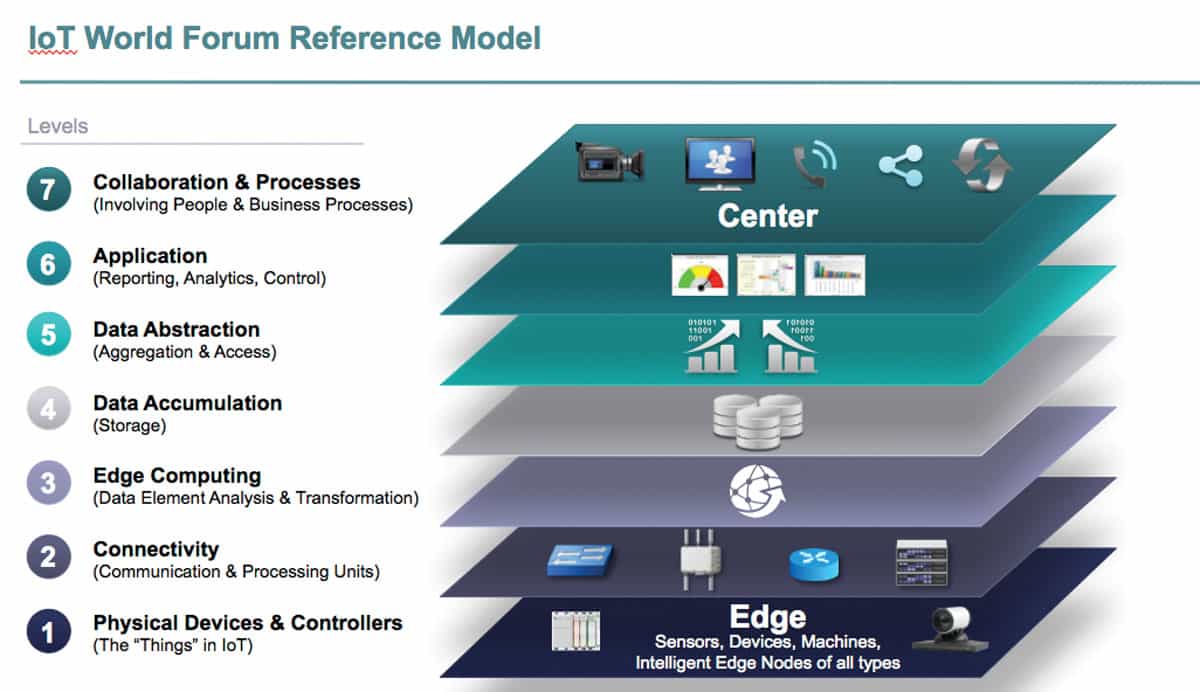Four considerations for moving forward
by Sanjay Kamani and Jonathan Tombes
Technology buzzwords come and go. But every now and then, one sticks. Take the Internet of Things (IoT). Fifteen years after the expression first appeared, it remains in use because its core concept – a network of smart devices – represents real technologies being applied across multiple industries. To date, IoT has gained traction in the consumer-electronics (CE), automotive and healthcare industries. Analysts forecast growth elsewhere.
In addition to conducting cost-benefit analysis, property managers looking into IoT-enabled elevator applications should consider these issues: system security, operational ownership, usability of data and systems architecture.
As IoT expands, another reason for its resilience is becoming clear. The term encompasses a wide range of technologies, some that predate it and others that emerged later. Earlier terms include “embedded industrial applications” and machine-to-machine (M2M) technology. More recently, IoT has overlapped with cloud computing. A recent article by Guy Gotlieb of Escalade Innovative Solutions (ELEVATOR WORLD, June 2015), for instance, discusses retrofitting elevators using M2M technology and cloud services. A similar article from executives at Qameleon Technology focuses on sensors and analytics (EW December 2014).
Third-party vendors naturally tout their strengths. On Microsoft’s website, an IoT case study with ThyssenKrupp highlights the software giant’s cloud capabilities. Going forward, the elevator industry will hear more about IoT. Our goal here is not to assess any particular implementations, but rather offer several general observations. In addition to conducting cost-benefit analysis, property managers looking into IoT-enabled elevator applications should consider these issues: system security, operational ownership, usability of data and systems architecture.
Security and Governance
Being internally and externally connected with a potentially large number of vendors, IoT raises security questions: Do appropriate data transfer standards exist? Which should be used? Do all devices have required security protocols? Which regulations are applicable? Are threat-monitoring and detection systems necessary? Is the data-collection system completely separate from any underlying operating system?
In addition to security, IoT raises broader governance issues involving data integrity, availability, audits, traceability and privacy. Some applications may involve minimal data transfer, with no privacy concerns and easily locked-down encryption, which simplifies matters. Vulnerabilities can nonetheless lead to disaster. Some IoT failures have become legendary, such as a thermostat in a U.S. Chamber of Commerce facility that was turned into a listening device and redirected to communicate with a Chinese Internet Protocol (IP) address, or the hacker who famously shut off the power in two of Amsterdam’s largest buildings.
Fortunately, applications are evolving to enable relatively simple and secure integration of devices, systems and assets. Industry groups such as the AllSeen Alliance and the Thread Group have included enhanced security algorithms in their projects, and major players are building systems that apply security from the core all the way to the display of data. This is good news for the elevator industry, which values reliability even more than innovation.
Ownership and Skills
In the big picture, the “Things” in IoT represent only the starting point. These physical devices and controllers are the first rung in the IoT World Forum’s multilevel reference model (Figure 1). Translated in operational terms, the IoT model impacts multiple processes and personnel.
The case of the compromised thermostat mentioned above illustrates the issue of ownership. As discussed in a recent U.S. government cybersecurity building control-systems workshop, that embarrassing incident raised immediate questions: Whose job is this? Does it belong to the facility’s mechanical engineers, or the Internet Technology teams more adept at handling layers two through seven, or both?
Collaboration can yield answers. Later in that workshop, Pentagon executive John Conger said having “both the facilities folks and the chief information officer folks in the same room” has led to “the most fruitful [meetings] that we’ve had.” Commercial and government real estate differ, but the common problem suggests a common solution: partnering across departmental lines and developing new skills and processes.
Data Processing and Analysis
The value of IoT depends upon the value of data. Wearable devices may be able to transmit biometrics, for instance, but they do not yield predictive healthcare insights on their own. Doing so requires a system that can process, analyze and transform these data into valuable information.
In an article mentioned above, executives from Qameleon Technology describe an approach to elevator monitoring that leverages sensors, analytics and data science. They also pointed out the advantage, and difficulty, of acquiring industry information that could supplement performance data. In this case, that has to do with how long parts last, the cost of repairs, historical records, etc.
Installing and connecting IoT devices are only the first steps. Conducting data-element analysis using “edge computing” takes you to level three in the IoT model. That may be sufficient. But, deriving more value from IoT, such as company- or industry-wide benchmarks, requires tapping into more data, which entails additional storage, aggregation, analytics and collaboration.
Systems Architecture
In the IoT ecosystem, there is strength in numbers. Consider an automobile accident-detection system able to interact with emergency response and medical care professionals in real time. If they share common protocols and design, separate systems can combine for a greater good.
For some of IoT’s predecessors, such as radio-frequency identification, other values outweigh interoperability. But, there is a strong case for moving from closed to open (yet secure) systems. The building industry, for instance, is fragmented with many divisions managing data on separate networks. Consolidation within a single IP network, however, can be key to maximizing benefits within an IoT framework (Figure 2). Those benefits may include cost efficiency, improved tenant/owner satisfaction and greater return on investment.
Deploying IoT, thus, not only entails understanding data collection, transmission, computing, analytics and decision modeling of a single system, it also calls for connecting subsystems to each other.
Not everything need be shared. Several years ago, we pointed out in these pages how a common electronic workflow and data-management platform would enable the elevator industry to improve and simplify operations, while ensuring safety-code compliance (EW, September 2012). On such a platform, the external interface with a municipality’s regulatory office would be isolated, while performance and compliance data could be shared on a common control and monitoring system.
Elevators make up one of several building subsystems that are candidates for “IoT-ization.”

Industry Change and IoT
There is a lot of buzz surrounding IoT, especially in the CE, automotive and healthcare industries. That will remain the case, but, over the next five years, rapid adoption in other industries will expand IoT into sectors that overlap with real estate. More grounded in civil and mechanical than software engineering, commercial real estate runs somewhat slower than “Internet speed.” But, change is underway. Online listing services are transforming the way property is marketed and sold, and IoT-based applications are converging with the industry’s “green” and smart-building initiatives.
Elevators make up one of several building subsystems that are candidates for “IoT-ization.” Rightly focused on safety and reliability, the industry should pay special attention to IoT-related questions of security and data governance. Other IoT considerations involve assigning the correct responsibilities to respective facilities management and IT teams, ensuring that data processing and analysis yield usable results and linking individual applications to a secure but shared control and monitoring infrastructure.
Get more of Elevator World. Sign up for our free e-newsletter.







